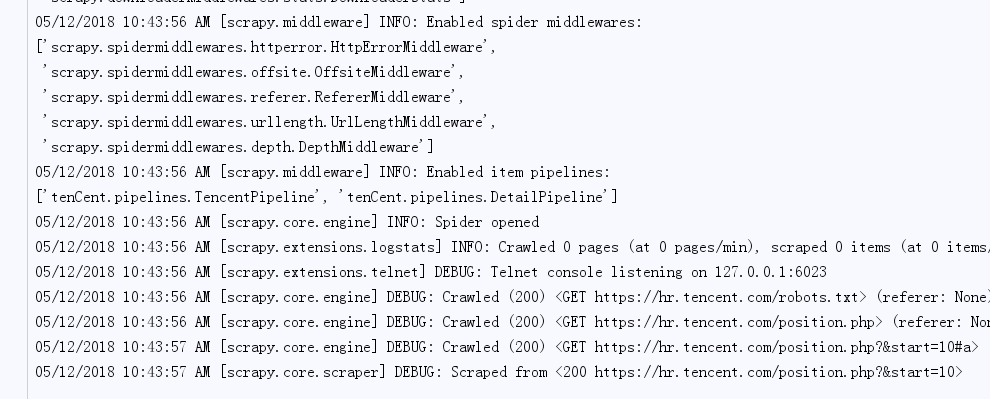CrawlSpider
Scrapy框架中分两类爬虫,Spider类和CrawlSpider类。
它是Spider的派生类,Spider类的设计原则是只爬取start_url列表中的网页,
而CrawlSpider类定义了一些规则(rule)来提供跟进link的方便的机制,从爬取的网页中获取link并继续爬取的工作更适合。
创建项目指令:
scrapy startproject tenCent
CrawlSpider创建:
scrapy genspider -t crawl crawl_tencent "hr.tencent.com"
CrawlSpider继承于Spider类,除了继承过来的属性外(name、allow_domains),还提供了新的属性和方法:
LinkExtractor
from scrapy.linkextractors import LinkExtractor
LinkExtractor(allow=r'start=\d+')
通过实例化LinkExtractor提取链接
主要参数
allow:满足括号中“正则表达式”的值会被提取,如果为空,则全部匹配。
deny:与这个正则表达式(或正则表达式列表)不匹配的URL一定不提取。
rules
Rule(LinkExtractor(allow=r'start=\d+'), callback='parse_tencent', follow=True),
在rules中包含一个或多个Rule对象,每个Rule对爬取网站的动作定义了特定操作。
如果多个rule匹配了相同的链接,则根据规则在本集合中被定义的顺序,第一个会被使用
主要参数
link_extractor:是一个Link Extractor对象,用于定义需要提取的链接
callback: 从link_extractor中每获取到链接时,参数所指定的值作为回调函数,该回调函数接受一个response作为其第一个参数。
注意:当编写爬虫规则时,避免使用parse作为回调函数。由于CrawlSpider使用parse方法来实现其逻辑,如果覆盖了 parse方法,crawl spider将会运行失败。
follow:是一个布尔(boolean)值,指定了根据该规则从response提取的链接是否需要跟进。 如果callback为None,follow 默认设置为True ,否则默认为False。
使用CrawlSpider爬取信息
1.编写item文件
# -*- coding: utf-8 -*- # Define here the models for your scraped items # # See documentation in: # https://doc.scrapy.org/en/latest/topics/items.html import scrapy class TencentItem(scrapy.Item): # define the fields for your item here like: # name = scrapy.Field() # 职位名称 position_name = scrapy.Field() # 详情链接 position_link = scrapy.Field() # 职位类别 position_type = scrapy.Field() # 职位人数 position_number = scrapy.Field() # 职位地点 work_location = scrapy.Field() # 发布时间 publish_times = scrapy.Field() # 工作职责 position_duty = scrapy.Field() # 工作要求 position_require = scrapy.Field() class DetailItem(scrapy.Item): # 工作职责 position_duty = scrapy.Field() # 工作要求 position_require = scrapy.Field()
2.编写crawlspider文件
# -*- coding: utf-8 -*- import scrapy from tenCent.items import TencentItem from tenCent.items import DetailItem from scrapy.linkextractors import LinkExtractor from scrapy.spiders import CrawlSpider, Rule class CrawlTencentSpider(CrawlSpider): name = 'crawl_tencent' allowed_domains = ['hr.tencent.com'] start_urls = ['https://hr.tencent.com/position.php'] ''' rule LinkExtractor规则: allow:根据正则表达式匹配链接 callback:回调函数 follow:是否提取跟进页(链接套链接) ''' rules = ( Rule(LinkExtractor(allow=r'start=\d+'), callback='parse_tencent', follow=True), # 从上面的规则传递下一个 Rule(LinkExtractor(allow=r'position_detail\.php\?id=\d+'), callback='parse_detail', follow=False), ) def parse_tencent(self, response): print('start……') node_list = response.xpath('//tr[@class="even"] | //tr[@class="odd"]') # 选取所有标签tr 且class属性等于even或odd的元素 #i['domain_id'] = response.xpath('//input[@id="sid"]/@value').extract() #i['name'] = response.xpath('//div[@id="name"]').extract() #i['description'] = response.xpath('//div[@id="description"]').extract() for node in node_list: item = TencentItem() item['position_name'] = node.xpath('./td[1]/a/text()').extract_first() # 获取第一个td标签下a标签的文本 item['position_link'] = node.xpath('./td[1]/a/@href').extract_first() # 获取第一个td标签下a标签href属性 item['position_type'] = node.xpath('./td[2]/text()').extract_first() # 获取第二个td标签下文本 item['position_number'] = node.xpath('./td[3]/text()').extract_first() # 获取第3个td标签下文本 item['work_location'] = node.xpath('./td[4]/text()').extract_first() # 获取第4个td标签下文本 item['publish_times'] = node.xpath('./td[5]/text()').extract_first() # 获取第5个td标签下文本 yield item def parse_detail(self, response): item = DetailItem() item['position_duty'] = ''.join( response.xpath('//ul[@class="squareli"]')[0].xpath('./li/text()').extract()) # 转化为字符串 item['position_require'] = ''.join( response.xpath('//ul[@class="squareli"]')[1].xpath('./li/text()').extract()) # 转化为字符串 yield item
3.建立pipeline文件
# -*- coding: utf-8 -*- # Define your item pipelines here # # Don't forget to add your pipeline to the ITEM_PIPELINES setting # See: https://doc.scrapy.org/en/latest/topics/item-pipeline.html import json from .items import TencentItem from .items import DetailItem class TencentPipeline(object): def open_spider(self, spider): """ # spider (Spider 对象) – 被开启的spider # 可选实现,当spider被开启时,这个方法被调用。 :param spider: :return: """ self.file = open('tencent.json', 'w', encoding='utf-8') json_header = '{ "tencent_info":[' self.count = 0 self.file.write(json_header) # 保存到文件 def close_spider(self, spider): """ # spider (Spider 对象) – 被关闭的spider # 可选实现,当spider被关闭时,这个方法被调用 :param spider: :return: """ json_tail = '] }' self.file.seek(self.file.tell() - 1) # 定位到最后一个逗号 self.file.truncate() # 截断后面的字符 self.file.write(json_tail) # 添加终止符保存到文件 self.file.close() def process_item(self, item, spider): """ # item (Item 对象) – 被爬取的item # spider (Spider 对象) – 爬取该item的spider # 这个方法必须实现,每个item pipeline组件都需要调用该方法, # 这个方法必须返回一个 Item 对象,被丢弃的item将不会被之后的pipeline组件所处理。 :param item: :param spider: :return: """ # print('item=',dict(item)) if isinstance(item, TencentItem): print('--'*20) content = json.dumps(dict(item), ensure_ascii=False, indent=2) + "," # 字典转换json字符串 self.count += 1 print('content', self.count) self.file.write(content) # 保存到文件 ''' return item后,item会根据优先级 传递到下一个管道DetailPipeline处理 此段代码说明当实例不属于TencentItem时,放弃存储json, 直接传递到下一个管道处理 return放在if外面,如果写在if里面item在不属于TencentItem实例后, item会终止传递,造成detail数据丢失 ''' return item class DetailPipeline(object): def open_spider(self, spider): """ # spider (Spider 对象) – 被开启的spider # 可选实现,当spider被开启时,这个方法被调用。 :param spider: :return: """ self.file = open('detail.json', 'w', encoding='utf-8') json_header = '{ "detail_info":[' self.count = 0 self.file.write(json_header) # 保存到文件 def close_spider(self, spider): """ # spider (Spider 对象) – 被关闭的spider # 可选实现,当spider被关闭时,这个方法被调用 :param spider: :return: """ json_tail = '] }' self.file.seek(self.file.tell() - 1) # 定位到最后一个逗号 self.file.truncate() # 截断后面的字符 self.file.write(json_tail) # 添加终止符保存到文件 self.file.close() def process_item(self, item, spider): """ # item (Item 对象) – 被爬取的item # spider (Spider 对象) – 爬取该item的spider # 这个方法必须实现,每个item pipeline组件都需要调用该方法, # 这个方法必须返回一个 Item 对象,被丢弃的item将不会被之后的pipeline组件所处理。 :param item: :param spider: :return: """ # print('item=',dict(item)) if isinstance(item, DetailItem): ''' 得到item,判断item实例属于DetailItem,存储json文件 如果不属于,直接return item到下一个管道 ''' print('**' * 30) content = json.dumps(dict(item), ensure_ascii=False, indent=2) + "," # 字典转换json字符串 self.count += 1 print('content', self.count) self.file.write(content) # 保存到文件 return item
4.设置settiing
#1、项目名称,默认的USER_AGENT由它来构成,也作为日志记录的日志名 BOT_NAME = 'tenCent' # 2、爬虫应用路径 SPIDER_MODULES = ['tenCent.spiders'] NEWSPIDER_MODULE = 'tenCent.spiders' # Crawl responsibly by identifying yourself (and your website) on the user-agent USER_AGENT = '"User-Agent":"Mozilla/5.0 (Windows NT 6.1; Win64; x64) AppleWebKit/537.36 (KHTML, like Gecko) Chrome/63.0.3239.132 Safari/537.36"' # 头部信息,反爬 # Obey robots.txt rules ROBOTSTXT_OBEY = True # log日志 LOG_FILE = 'tencent.log' LOG_LEVEL = 'DEBUG' LOG_ENCODING = 'utf-8' LOG_DATEFORMAT='%m/%d/%Y %H:%M:%S %p' ITEM_PIPELINES = { 'tenCent.pipelines.TencentPipeline': 300, 'tenCent.pipelines.DetailPipeline':400 }
5.执行程序
scrapy crawl crawl_tencent
tencent.log

tencent.json

detail.json
